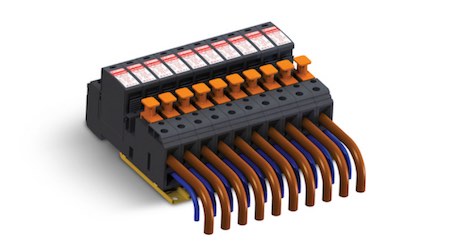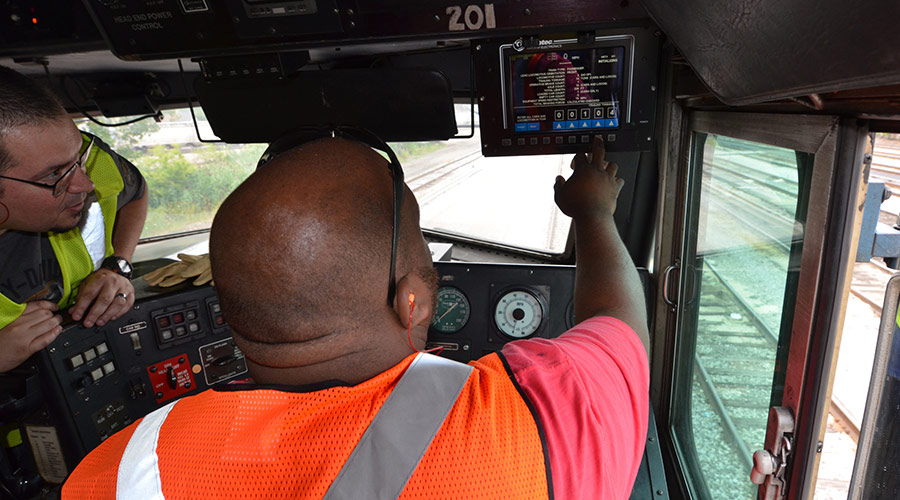Stay updated on news, articles and information for the rail industry
June 2016
Rail News: PTC
Perspective: Taking the Surprise Out of Protecting PTC Systems
By Dick March and John Moore
There are surprises, then there are surprises. Most people like the kind with gifts or the unexpected family and friends gathering. Then there are those costly maintenance surprises that can challenge your day, causing system downtime and inconveniences.
Railroad managers and maintainers don't like seeing those surprises during inspections, especially those from damaging lightning events.
 Phoenix Contact's VAL MS-BE-AR line of surge protection devices can help address requirements of the PTC era in a wayside bungalow lightning protection network, the company says.
Phoenix Contact's VAL MS-BE-AR line of surge protection devices can help address requirements of the PTC era in a wayside bungalow lightning protection network, the company says.Photo: Phoenix Contact
Many maintainers will tell you that they are blind to what is happening with the primary AAR surge protection in signal bungalows until either their monthly inspection, or their equipment fails. This visual inspection process is very subjective. Maintainers have to make a judgment call to determine if any surge protection devices (SPDs) have shorted. What's the percentage of carbon flash on the traditional clear cover? Are there any missing spark-gap teeth? How many air gaps are compromised? Do they meter well?
Time is money, and this process is time-consuming and potentially inaccurate. Railroad managers want better reliability and uptime stability. There is a greater need for remote monitoring of alarms, pinpointing where those trouble spots are when they happen and minimizing exposure vulnerabilities. It would also be nice to be able to make simple change-out corrections without just relying on visual inspection, shutting down systems or disarranging wires. "Knowing before going" is very valuable. If maintainers have a way to data log and time stamp remote event alarms locally, this will dramatically reduce system vulnerabilities and the surprise element.
This has become even more valuable over the past decade, as the industry has been forced to move from electromechanical devices to solid-state versions. Obsolescence and positive train control (PTC) are accelerating those changes. Now the industry is at the point where five or ten discrete devices have been combined into one multi-function "super device." This is appealing for many different reasons. Too often, however, these super-electronic devices are failing for undetermined causes and have to be replaced at great cost, with no option of reverting back or to a lesser level of automation just to keep up minimum levels of service.
The FRA's 49 CFR 236.1023 PTC rule bolsters the need for monitoring and reporting. The rule stipulates that all failures within the PTC system and associated products must be reported and cataloged, diagnosed and corrective actions reported. It states, "Each railroad implementing a PTC system on its property shall establish and continually update a PTC Product Vendor List (PTCPVL) that includes all vendors and suppliers of each PTC system, subsystem, component, and associated product, and process in use system-wide."
The intent is for reporting of errors and malfunctions for all devices related to PTC systems. As a best practice interpretation, all local signal circuits that are feeding data to the PTC system are included in the CFR rule. To comply, railroads should also be reporting failures on primary surge arresters. Furthermore, a surge protector — a primary field component — on that signal can now be included. Until now, there has been no definitive way to determine that SPDs failed.
Taken to the logical conclusion, railroad signal surge protection with status feedback "indicating failure" should be applied on PTC-associated systems and signals. Modern SPDs for the railroad industry, such as Phoenix Contact's VAL MS-BE-AR, address the requirements of the PTC era in wayside bungalow lightning protection network from an electrical and mechanical standpoint. The BE-AR device's remote sensing feature lets a maintainer know when an SPD has been compromised, and exactly which SPD elements must be replaced. It is hot-swappable, so it eliminates the need to unnecessarily field-wire multiple replacements.
By implementing a modern lightning protection network, you can eliminate the unwanted surprises in your bungalows, while enhancing and protecting your expensive PTC system.
Dick March and John Moore are both senior business development managers for transportation infrastructure at Phoenix Contact.


 2025 MOW Spending Report: Passenger-rail programs
2025 MOW Spending Report: Passenger-rail programs
 Gardner steps down as Amtrak CEO
Gardner steps down as Amtrak CEO
 Guest comment: Oliver Wyman’s David Hunt
Guest comment: Oliver Wyman’s David Hunt
 Women of Influence in Rail eBook
Women of Influence in Rail eBook
 railPrime
railPrime







